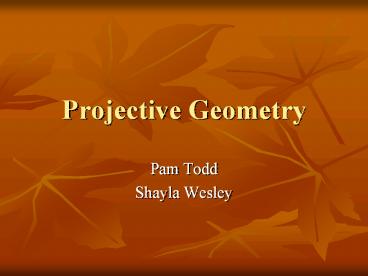Projective Geometry - PowerPoint PPT Presentation
Title:
Projective Geometry
Description:
Projective Geometry Pam Todd Shayla Wesley Summary Conic Sections Define Projective Geometry Important Figures in Projective Geometry Desargues Theorem Principle ... – PowerPoint PPT presentation
Number of Views:394
Avg rating:3.0/5.0
Title: Projective Geometry
1
Projective Geometry
- Pam Todd
- Shayla Wesley
2
Summary
- Conic Sections
- Define Projective Geometry
- Important Figures in Projective Geometry
- Desargues Theorem
- Principle of Duality
- Brianchons Theorem
- Pascals Theorem
3
Conic Sections
- a conic section is a curved locus of points,
formed by intersecting a cone with a plane
- Two well-known conics are the circle and the
ellipse. These arise when the intersection of
cone and plane is a closed curve. - Conic Sections 2
4
What is Projective Geometry?
- Projective geometry is concerned with where
elements such as lines planes and points either
coincide or not. - Can be thought of informally as the geometry
which arises from placing one's eye at a point.
That is, every line which intersects the "eye"
appears only as a point in the projective plane
because the eye cannot "see" the points behind
it.
5
Beginnings
- Artists had a hard time portraying depth on a
flat surface - Knew their problem was geometric so they began
researching mathematical properties on spatial
figures as the eye sees them - Filippo Brunelleschi made the 1st intensive
efforts other artists followed
6
Leone Battista Alberti
- 1404-1472
- Thought of the surface of a picture as a window
or screen through which the artist views the
object to be painted - Proposed the following procedure interpose a
glass screen between yourself and the object,
close one eye, and mark on the glass the points
that appear to be on the image. The resulting
image, although two-dimensional, will give a
faithful impression of the three-dimensional
object.
7
Leone Battista Alberti
- Since we are free to move our eye and the
position of the screen, we have many different
two-dimensional representations of the
three-dimensional object. An interesting problem,
raised by Alberti himself, is to recognize the
common properties of all these different
representations.
8
Gerard Desargues
- 1593-1662
- Wrote Rough draft for an essay on the results of
taking plane sections of a cone - The book is short, but very dense. It begins with
pencils of lines and ranges of points on a line,
considers involutions of six points gives a
rigorous treatment of cases involving 'infinite'
distances, and then moves on to conics, showing
that they can be discussed in terms of properties
that are invariant under projection.
9
Desargues Famous Theorem
- DESARGUES THEOREM If corresponding sides of two
triangles meet in three points lying on a
straight line, then corresponding vertices lie on
three concurrent lines - Desargues Theorem, Three Circles Theorem using
Desargues Theorem
10
Gaspard Monge
- 1746-1818
- Invented descriptive geometry (aka representing
three-dimensional objects in a two-dimensional
plane)
11
Jean-Victor Poncelet
- 1788-1867
- studied conic sections and developed the
principle of duality independently of Joseph
Gergonne - Student of Monge (Three Circle Theorem)
12
Whats a duality?
- How it came about?
- Euclidean geometry vs. projective geometry
- Train tracks
- Euclidean-two points determine a line
- Projective-two lines determine a point
13
Principle of Duality
- All the propositions in projective geometry occur
in dual pairs which have the property that,
starting from either proposition of a pair, the
other can be immediately inferred by
interchanging the words line and point. - This also applies with words such as vertex and
side to get dual statements about vertices.
14
Dual it yourself!
- Through every pair of distinct points there is
exactly one line, and - There exists two points and two lines such that
each of the points is on one of the lines and - There is one and only one line joining two
distinct points in a plane, and
15
Pascals Theorem
- Discovered by Pascal in 1640 when he was only 16
years old. - Basic idea of the theorem was given a (not
necessarily regular, or even convex) hexagon
inscribed in a conic section, the three pairs of
the continuations of opposite sides meet on a
straight line, called the Pascal line
16
Brianchons Theorem
- Brianchons theorem is the dual of Pascals
theorem - States given a hexagon circumscribed on a conic
section, the lines joining opposite polygon
vertices (polygon diagonals) meet in a single
point
17
Time Line
- 14th century
- Artists studied math properties of spatial
figures - Leone Alberti thought of screen images to be
projections - 15th century
- Gerard Desargues wrote Rough draft for an essay
on the results of taking plane sections of a cone
- 16th Century
- Pascal came up with theorem for Pascal's line
based on a hexagon inscribed in a conic section. - 17th Century
- Victor Poncelet came up with principle of duality
- Joseph Diaz Gergonne came up with a similar
principle independent of Poncelet - Charles Julien Brianchon came up with the dual of
Pascals theorem
18
Bibliography
- Leone Battista Alberti http//www-groups.dcs.st-an
d.ac.uk/history/Mathematicians/Alberti.html - Projective Geometry http//www.anth.org.uk/NCT/
- Math World http//mathworld.wolfram.com/
- Desargues' theorem http//www.cut-the-knot.org/Cur
riculum/Geometry/Desargues.shtml - Monge via Desargues http//www.cut-the-knot.org/Cu
rriculum/Geometry/MongeTheorem.shtml - Intro to Projective Geometry http//www.math.poly.
edu/courses/projective_geometry/Inaugural-Lecture/
inaugural.html - Conic Section http//en.wikipedia.org/wiki/Conic_s
ection - Jean-Victor Poncelet http//en.wikipedia.org/wiki/
Jean_Victor_Poncelet - Gaspard Monge http//www.britannica.com/eb/article
-9053349































